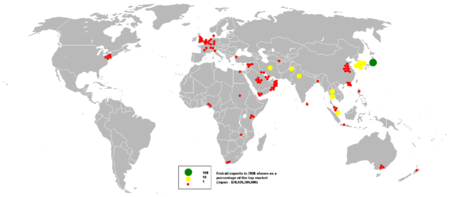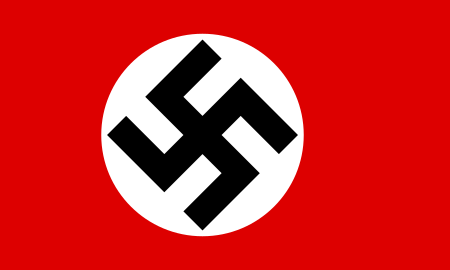Battle of Florvåg
| |||||||||||||||||||||||||||||
Read other articles:

Pertanian sebagai upaya dalam pemenuhan hak atas pangan. Hak atas pangan, dan ragamnya, adalah sebuah hak asasi manusia yang melindungi hak seseorang untuk ketersediaan pangan, mendapatkan makanan layak, mendapatkan akses pangan, dan memenuhi kebutuhan nutrisi. Hak atas pangan melindungi hak seluruh manusia untuk bebas dari kelaparan, ketidakamanan pangan dan malnutrisi.[1] Hak atas pangan tidak dapat diabaikan karena hak atas pangan adalah bagian dari hak asasi manusia.[2] Defin…

Môn thể thao dùng gậy đánh bóngBản mẫu:SHORTDESC:Môn thể thao dùng gậy đánh bóng GolfMột tay golf ở tư thế kết thúc sau một cú phát bóngCơ quan quản lý cao nhấtThe R&AUSGAIGFThi đấu lần đầuThế kỷ 15 ở ScotlandĐặc điểmVa chạmKhôngHình thứcNgoài trờiTrang bịGậy golf, bóng golf, và nhiều dụng cụ khácHiện diệnQuốc gia hoặc vùngNam phi, Canda, Vương quốc Anh , Tây …

Canadian baked goods producer This article has multiple issues. Please help improve it or discuss these issues on the talk page. (Learn how and when to remove these template messages) The topic of this article may not meet Wikipedia's notability guidelines for companies and organizations. Please help to demonstrate the notability of the topic by citing reliable secondary sources that are independent of the topic and provide significant coverage of it beyond a mere trivial mention. If notability …

关于与「內閣總理大臣」標題相近或相同的条目页,請見「內閣總理大臣 (消歧義)」。 日本國內閣總理大臣內閣總理大臣紋章現任岸田文雄自2021年10月4日在任尊称總理、總理大臣、首相、阁下官邸總理大臣官邸提名者國會全體議員選出任命者天皇任期四年,無連任限制[註 1]設立法源日本國憲法先前职位太政大臣(太政官)首任伊藤博文设立1885年12月22日,…

جوزيف جوفري (بالفرنسية: Joseph Joffre) معلومات شخصية اسم الولادة (بالفرنسية: Joseph Jacques Césaire Joffre) الميلاد 12 يناير 1852(1852-01-12)فرنسا الوفاة 3 يناير 1931 (78 سنة)باريس، فرنسا مكان الدفن ليزانفاليد، ولوفيسين [لغات أخرى] الجنسية فرنسا عضو في الأكاديمية الفرنسية، �…

伊斯兰合作组织Organisation of Islamic Cooperation(英語)Organisation de la Coopération Islamique(法語)منظمة التعاون الإسلامي(阿拉伯語) 旗帜格言:To safeguard the interests and ensure the progress and well-being of Muslims 成员国 观察国 暂停会籍行政总部 沙地阿拉伯吉达 官方语言阿拉伯语英语法语类型宗教成员国57个在籍成员国(英语:Member states of the Organisation of …

New Zealand cyclist Ella WylliePersonal informationBorn (2002-09-01) 1 September 2002 (age 21)Team informationCurrent teamLiv AlUla JaycoDisciplineRoadRoleRiderAmateur team2020–2021Velo Project Professional teams2022Parkhotel Valkenburg2023Lifeplus Wahoo2024–Liv AlUla Jayco Major winsOne-day races and Classics National Road Race Championships (2024) Ella Wyllie (born 1 September 2002) is a New Zealand professional racing cyclist,[1] who currently rides for UCI Women's World…

American animation film production company IlluminationLogo used since 2017FormerlyIllumination Entertainment (2007–2017)Company typeDivisionIndustryAnimationMotion picturesTelevision specialsFoundedJanuary 17, 2007; 17 years ago (2007-01-17)FounderChris MeledandriHeadquarters2049 Colorado Ave, Santa Monica, California, U.S.Key people Chris Meledandri (CEO)[1] Keith Feldman (COO)[2] Number of employees100 (2016)[3]ParentUniversal PicturesDivisions Illu…

Pour un article plus général, voir Inondation. Ne doit pas être confondu avec Lave torrentielle. Inondation boueuse à Chaumont-Gistoux, dans le centre de la Belgique. Une inondation boueuse résulte d'une accumulation de ruissellement, généré au niveau de terres agricoles, qui emporte au passage des particules de terre qu'il transporte comme matière en suspension ou charge de fond. Ce ruissellement boueux est détecté lorsqu'il aboutit dans des zones habitées. Les inondations boueuses …

Postwar academic movement in economics For the contemporary consensus in macroeconomics, see New neoclassical synthesis. Part of a series onMacroeconomics Basic concepts Aggregate demand Aggregate supply Business cycle CAGR Deflation Demand shock Disinflation Effective demand Expectations Adaptive Rational Financial crisis Growth Inflation Demand-pull Cost-push Interest rate Investment Liquidity trap Measures of national income and output GDP GNI NNI Microfoundations Money Endogenous Money creat…

Economy of the United Arab EmiratesDubai, the financial center of the United Arab EmiratesCurrencyEmirati dirham (AED, د.إ)Fixed exchange ratesUS$1 = 3.6725 AEDFiscal yearCalendar yearTrade organisationsOPEC, WTO, GCC, BRICSCountry group Developed country[1] High-income economy[2] Oil-based economy, seeking to diversify[3] StatisticsPopulation 9,441,129 (2022)[4]GDP $527.80 billion (nominal; 2024 est.)[1] $948.05 billion (PPP; 2024 est.)[1] GDP r…

Pashtun-style minced kebab eaten throughout South Asia Chapli kababLamb chapli kabab served at a Balti restaurant in Birmingham, UKAlternative namesPeshawari chapli kababTypeKebabCourseAppetiser, main course or side dishPlace of originPeshawar, Pakistan[1][2][3][4]Associated cuisinePakistani,[5] AfghanMain ingredientsMinced beef, mutton, or chickenIngredients generally usedVarious herbs and spicesSimilar dishesBurgers Media: Chapli kabab Cha…

Dutch footballer (born 2003) Devyne Rensch Rensch with Ajax in 2024Personal informationFull name Devyne Fabian Jairo Rensch[1]Date of birth (2003-01-18) 18 January 2003 (age 21)Place of birth Lelystad, Netherlands[2]Height 1.83 m (6 ft 0 in)[3]Position(s) Right-back, Centre-backTeam informationCurrent team AjaxNumber 2Youth career0000–2016 VV Unicum2016–2020 AjaxSenior career*Years Team Apps (Gls)2020– Jong Ajax 16 (3)2020– Ajax 91 (9)Internati…

Carta strutturale semplificata delle Alpi Il Dominio Sudalpino (detto anche Falda Sudalpina, oppure, più semplicemente, Sudalpino) è un preciso settore della catena alpina, delimitato da lineamenti geodinamici rilevanti a scala regionale, che si estende dal Canavese alle Alpi Dinaridi per una lunghezza di circa 700 km; la sua larghezza è variabile da meno di 50 a 150 km. Questo settore risulta compreso tra il lineamento insubrico a settentrione e l'avampaese padano a sud. È costitu…

Stasiun Kutablang CM05 Stasiun Kutablang baruLokasiGle Putoh, Kuta Blang, Bireuen, AcehIndonesiaKoordinat5°12′42.620″N 96°50′35.855″E / 5.21183889°N 96.84329306°E / 5.21183889; 96.84329306Koordinat: 5°12′42.620″N 96°50′35.855″E / 5.21183889°N 96.84329306°E / 5.21183889; 96.84329306Ketinggian+35,60 mOperator Sub Divisi Regional I.1 Aceh Letakkm 209+969 lintas Ulee Lheue–Banda Aceh–Sigli–Langsa–Pangkalan Susu[1]…

Untuk bendera Guinea, lihat Bendera Guinea. Rasio bendera: 1:2 Bendera Guinea Bissau disetujui tahun 1973 ketika kemerdekaan dari Portugal diperoleh. Bendera ini memiliki warna tradisional pan-Afrika emas, hijau, merah, juga Bintang Hitam Afrika. Rancangan bendera sangat dipengaruhi bendera Ghana. Warnanya memiliki arti yang sama: merah untuk darah martir, hijau untuk hutan, dan emas untuk kekayaan mineral. Lihat pula Bendera Tanjung Verde Pranala luar Guinea-Bissau di Flags of the World lbsBend…

Garangan hidung panjang Herpestes naso Status konservasiRisiko rendahIUCN41615 TaksonomiKelasMammaliaOrdoCarnivoraFamiliHerpestidaeGenusHerpestesSpesiesHerpestes naso De Winton, 1901 DistribusiPeta sebaran spesies Garangan hidung panjang (Xenogale naso) adalah sebuah spesies garangan yang berasari dataran basah dan hutan hujand di Afrika Tengah. Spesies ini telah dimasukkan sebagai spesies risiko rendah pada Daftar Merah IUCN sejak 1996. Meski sebelumnya diklasifikasikan didalam Herpestes, studi…

يو-100 الجنسية ألمانيا النازية الشركة الصانعة فريدريش كروب المالك كريغسمارينه المشغل كريغسمارينه المشغلون الحاليون وسيط property غير متوفر. المشغلون السابقون وسيط property غير متوفر. التكلفة وسيط property غير متوفر. منظومة التعاريف الاَلية للسفينة وسيط property غير متوفر. …

Cet article est une ébauche concernant un architecte serbe. Vous pouvez partager vos connaissances en l’améliorant (comment ?) selon les recommandations des projets correspondants. Petar Bajalović Présentation Naissance 27 mai 1876Šabac, Principauté de Serbie Décès 14 avril 1947 (à 70 ans)Belgrade, Yougoslavie Nationalité Serbe Activités Architecte modifier Petar Bajalović (en serbe cyrillique : Петар Бајаловић ; né le 27 mai 1876 à Šabac …

Medieval coin Denier of Charlemagne. AD 768–814. 21mm, 1.19 g, Toulouse mint. Denier of Pepin I of Aquitaine 817–838. Denier of the Republic of Genoa (1139–1339). The denier (/dəˈnɪər/; Latin: denarius, Italian: denaro, Greek: δηνάριο, romanized: dinario; abbr. d.) or penny was a medieval coin which takes its name from the Frankish coin first issued in the late seventh century;[1] in English it is sometimes referred to as a silver penny. Its appearance represen…

